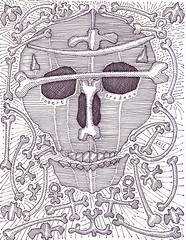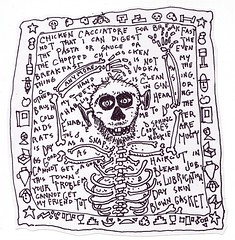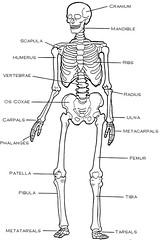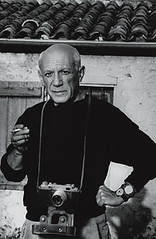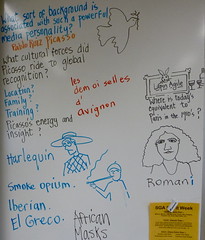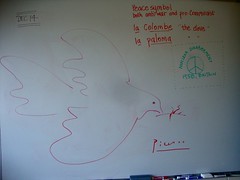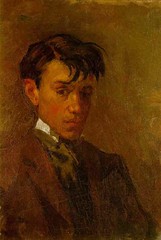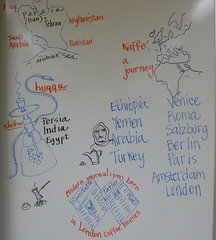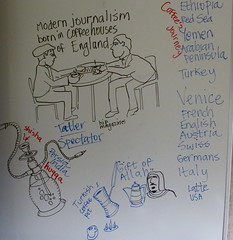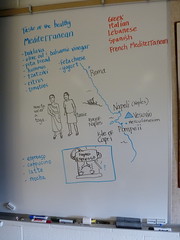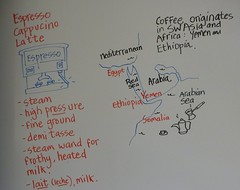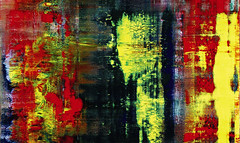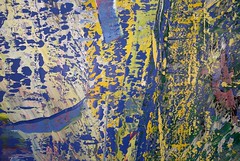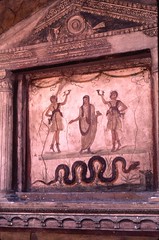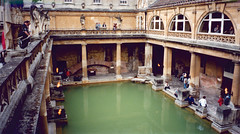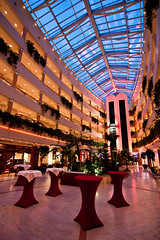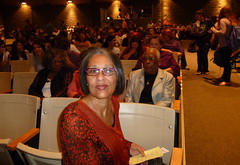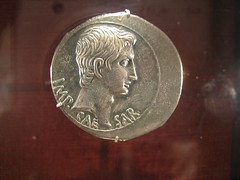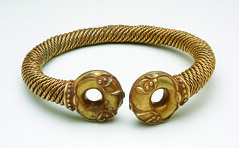A hybrid of Aztec and Catholic rituals, Dia de los Muertos is based on ancestor worship.
Notes on Dia -
- Celebrated on Nov 1, All Saints Day, Nov 2, All Souls Day in the Catholic Church.
- Partying in the cemeteries. Food, drink and talking with long-time friends.
- Pan de Muertos.
- Tequila: distilled from the Blue Agave cactus.
- Candles and marigolds. Sometimes Monarch butterflies.
- Papel Picado: symmetric and figurative scenes cut in tissue paper.
- Ofrendas (offering); an altar laden with food, drink and mementoes dedicated to a beloved ancestor.
- Calacas: skulls.
- Calaveras: skeletons - often clad in items suggestive of people in all occupations.
- Catrina: female, well-to-do skeleton.
- Pagan: pre-Christian worship.
Anatomy of a skeleton's bones.
- cranium
- mandible
- vertebrae
- clavicle
- sternum
- scapula
- rib cage
- humerus
- radius and ulna
- carpal bones
- metacarpals
- phalanges
- pelvic girdle
- coccyx
- femur
- patella
- fibula and tibia
- tarsal bones
- metatarsals
- phalanges
Wednesday, October 31, 2012
Chicken of the Dead quiz
Cranial Supper quiz
1. The brain case: the __ .
2. The somewhat triangular shoulder blade: a) scapula b) sternum c) mandible d) femur.
3. The collar bone: ___ . a) patella b) clavicle c) mandible d) femur.
4. The bone that supports your biceps: __ . a) mandible b) fibula c) femur d) humerus.
5. The radius and ulna are associated with your a) neck b) spine c) shin d) forearm.
6. The phalanx bones are part of your a) legs and arms b) hands and feet c) vertebrae and cranium d) ribs and pelvis.
7. The tarsus is associated with the __ . a) foot b) hand c) neck d) pelvis.
8. The pair of bones that comprise your shins: __ . a) tibia and fibula b) ulna and radius c) carpal and metacarpal d) humerus and radius.
9. The vertabrae are connected to the __ . a) mandible b) ribs c) pelvis d) ulna.
10. Your tailbone, or coccyx, is part of the a) os coxae b) carpals c) cranium d) calliope.
1. The brain case: the __ .
2. The somewhat triangular shoulder blade: a) scapula b) sternum c) mandible d) femur.
3. The collar bone: ___ . a) patella b) clavicle c) mandible d) femur.
4. The bone that supports your biceps: __ . a) mandible b) fibula c) femur d) humerus.
5. The radius and ulna are associated with your a) neck b) spine c) shin d) forearm.
6. The phalanx bones are part of your a) legs and arms b) hands and feet c) vertebrae and cranium d) ribs and pelvis.
7. The tarsus is associated with the __ . a) foot b) hand c) neck d) pelvis.
8. The pair of bones that comprise your shins: __ . a) tibia and fibula b) ulna and radius c) carpal and metacarpal d) humerus and radius.
9. The vertabrae are connected to the __ . a) mandible b) ribs c) pelvis d) ulna.
10. Your tailbone, or coccyx, is part of the a) os coxae b) carpals c) cranium d) calliope.
Sunday, October 28, 2012
A basis for creating three dimensional art: the skeleton, from cranium to metatarsals
Dia de Los Muertos project time:
Each group of 4 students - groups assigned by the teacher to expand classroom networks - will be responsible for delivering by Th, Nov 1 or Fri, Nov 2.
Those are the Christian celebrations called All Saints and All Souls Days - Dia de los Muertos is celebrated principally on All Souls.
a) Large, painted, articulated skeleton model - paper or cardboard.
b) Anatomy lesson and quiz.
c) Dia de los Muertos lesson and quiz.
Each group of 4 students - groups assigned by the teacher to expand classroom networks - will be responsible for delivering by Th, Nov 1 or Fri, Nov 2.
Those are the Christian celebrations called All Saints and All Souls Days - Dia de los Muertos is celebrated principally on All Souls.
a) Large, painted, articulated skeleton model - paper or cardboard.
b) Anatomy lesson and quiz.
c) Dia de los Muertos lesson and quiz.
Thursday, October 25, 2012
What Bill Gates, Paul Allen and other moguls do with some of their millions: learn about the fine arts and collect art
Bill Gates and Paul Allen, each bigillionaires because of their success as founders of Microsoft, have amassed large art collections.
Like you, they took fine arts classes when they were young. As their success in the business world grew, their sense of what to buy with their money turned to art.
For many billionaires, says Forbes.com, the art purchases they've made has been a profitable move.
Eric Clapton, rock guitarist and songwriter, recently made millions when he auctioned a painting by Gerhard Richter that he'd bought in the 1990's.
Like you, they took fine arts classes when they were young. As their success in the business world grew, their sense of what to buy with their money turned to art.
For many billionaires, says Forbes.com, the art purchases they've made has been a profitable move.
Eric Clapton, rock guitarist and songwriter, recently made millions when he auctioned a painting by Gerhard Richter that he'd bought in the 1990's.
Wednesday, October 24, 2012
Picasso was enthralled by the outcast Romani
The Romani are an ethnic group living mostly in Europe, says Wikipedia, who trace their origins to the Indian Subcontinent.
Romani are known in the English-speaking world by the exonym Gypsies (or Gipsies).
They are known collectively in the Romani language as Romane, Roma or Roms.
Their largest concentrated populations in Europe, especially the Roma of Central and Eastern Europe and Anatolia, followed by the Kale of Iberia and Southern France.
There are an estimated one million Roma in the United States; 800,000 in Brazil, whose ancestors were deported by the government of Portugal during the colonial era.
During World War II, the Nazis embarked on a systematic genocide of the Romani.[62] Romanies were marked for extermination and sentenced to forced labor and imprisonment in concentration camps.
They were often killed on sight, especially by the Einsatzgruppen (mobile killing units) on the Eastern Front.[citation needed] The total number of victims has been variously estimated at between 220,000 to 1,500,000; even the lowest number would make the Porajmos one of the largest mass murders in history.
The distinctive sound of Romani music has strongly influenced bolero, jazz, and flamenco (especially cante jondo) in Europe. European-style gypsy jazz is still widely practiced; one who acknowledged this artistic debt was guitarist Django Reinhardt, a Belgian gypsy.
Romani are known in the English-speaking world by the exonym Gypsies (or Gipsies).
They are known collectively in the Romani language as Romane, Roma or Roms.
Their largest concentrated populations in Europe, especially the Roma of Central and Eastern Europe and Anatolia, followed by the Kale of Iberia and Southern France.
There are an estimated one million Roma in the United States; 800,000 in Brazil, whose ancestors were deported by the government of Portugal during the colonial era.
During World War II, the Nazis embarked on a systematic genocide of the Romani.[62] Romanies were marked for extermination and sentenced to forced labor and imprisonment in concentration camps.
They were often killed on sight, especially by the Einsatzgruppen (mobile killing units) on the Eastern Front.[citation needed] The total number of victims has been variously estimated at between 220,000 to 1,500,000; even the lowest number would make the Porajmos one of the largest mass murders in history.
The distinctive sound of Romani music has strongly influenced bolero, jazz, and flamenco (especially cante jondo) in Europe. European-style gypsy jazz is still widely practiced; one who acknowledged this artistic debt was guitarist Django Reinhardt, a Belgian gypsy.
Cannot compare Picasso to Steve Jobs if you don't know the Jobs bio
Steven Paul "Steve" Jobs (1955 – 2011)[6][7] was an American entrepreneur best known as the co-founder, chairman, and CEO of Apple Inc.
He was widely recognized as a charismatic pioneer of the personal computer revolution[9][10], says Wikipedia. Jobs also co-founded Pixar Animation Studios.
Jobs oversaw the development of the iMac, iTunes, iPod, iPhone, and iPad, and the company's Apple Retail Stores, iTunes Store and the App Store.[17] The success of these products and services propelled Apple to become the world's most valuable publicly traded company in 2011.[18]
The reinvigoration of the company after the mid-1990's is regarded by many commentators as one of the greatest turnarounds in business history.
He was raised by adoptive parents in San Francisco. His father taught him to rebuild radios and TV's in the garage.
In 1972, Jobs enrolled at Reed College in Portland, Oregon. He dropped out of college after six months and spent the next 18 months dropping in on creative classes, including a course on calligraphy.[41] He continued auditing classes at Reed while sleeping on the floor in friends' dorm rooms, returning Coke bottles for food money, and getting weekly free meals at the local Hare Krishna temple.[42]
He traveled to India in mid-1974[44] with a Reed College friend (and, later, an early Apple employee), Daniel Kottke, in search of spiritual enlightenment.
Staying for seven months, Jobs shaved his head and wore traditional Indian clothing.[47][48] During this time, Jobs experimented with psychedelics, later calling his LSD experiences "one of the two or three most important things [he had] done in [his] life".[49][50] He also became a serious practitioner of Zen Buddhism, engaged in lengthy meditation retreats at the Tassajara Zen Mountain Center. He maintained a lifelong appreciation for Zen.[52]
Jobs and Steve Wozniak met in 1971. Wozniak had designed a low-cost digital "blue box" to generate the necessary tones to manipulate the telephone network, allowing free long-distance calls. Jobs decided that they could make money selling it. The clandestine sales of the illegal "blue boxes" went well, and perhaps planted the seed in Jobs's mind that electronics could be fun and profitable.[55]
When Woz revealed that he had invented a computer in 1976 (the Apple I ), they founded Apple computer in the garage of Jobs's parents in order to sell it.[59]
Jobs's design aesthetic was influenced by the modernist architectural style of Joseph Eichler, and the industrial designs of Braun's Dieter Rams.[36] His design sense was also greatly influenced by the Buddhism which he experienced in India while on a seven-month spiritual journey.[126] His sense of intuition was also influenced by the spiritual people with whom he studied.[126]
He was widely recognized as a charismatic pioneer of the personal computer revolution[9][10], says Wikipedia. Jobs also co-founded Pixar Animation Studios.
Jobs oversaw the development of the iMac, iTunes, iPod, iPhone, and iPad, and the company's Apple Retail Stores, iTunes Store and the App Store.[17] The success of these products and services propelled Apple to become the world's most valuable publicly traded company in 2011.[18]
The reinvigoration of the company after the mid-1990's is regarded by many commentators as one of the greatest turnarounds in business history.
He was raised by adoptive parents in San Francisco. His father taught him to rebuild radios and TV's in the garage.
In 1972, Jobs enrolled at Reed College in Portland, Oregon. He dropped out of college after six months and spent the next 18 months dropping in on creative classes, including a course on calligraphy.[41] He continued auditing classes at Reed while sleeping on the floor in friends' dorm rooms, returning Coke bottles for food money, and getting weekly free meals at the local Hare Krishna temple.[42]
He traveled to India in mid-1974[44] with a Reed College friend (and, later, an early Apple employee), Daniel Kottke, in search of spiritual enlightenment.
Staying for seven months, Jobs shaved his head and wore traditional Indian clothing.[47][48] During this time, Jobs experimented with psychedelics, later calling his LSD experiences "one of the two or three most important things [he had] done in [his] life".[49][50] He also became a serious practitioner of Zen Buddhism, engaged in lengthy meditation retreats at the Tassajara Zen Mountain Center. He maintained a lifelong appreciation for Zen.[52]
Jobs and Steve Wozniak met in 1971. Wozniak had designed a low-cost digital "blue box" to generate the necessary tones to manipulate the telephone network, allowing free long-distance calls. Jobs decided that they could make money selling it. The clandestine sales of the illegal "blue boxes" went well, and perhaps planted the seed in Jobs's mind that electronics could be fun and profitable.[55]
When Woz revealed that he had invented a computer in 1976 (the Apple I ), they founded Apple computer in the garage of Jobs's parents in order to sell it.[59]
Jobs's design aesthetic was influenced by the modernist architectural style of Joseph Eichler, and the industrial designs of Braun's Dieter Rams.[36] His design sense was also greatly influenced by the Buddhism which he experienced in India while on a seven-month spiritual journey.[126] His sense of intuition was also influenced by the spiritual people with whom he studied.[126]
The Mediterranean to Montmartre: the life of Picasso
Picasso quiz
1. Picasso was born in the Spanish city of a) Malaga b) Coruna c) Madrid d) Barcelona.
2. He became an accomplished painter as a teen. T / F
3. He was from a notable region of Spain called a) Basque b) Alsace
c) Catalonia d) Andalusia.
4. Picasso's most-loved sport: a) futbol b) handball c) mountain hiking d) bull fights.
5. He was born in poverty but was enormously successful as a painter. T / F
6. Picasso's Big Apple was a) Paris b) Madrid c) NYC d) London.
7. Picasso was a member of the group of European artists who called themselves the surrealists. T / F
8. Picasso was a member of the group of European artists who called themselves the fauvists (French: "savages"). T / F
9. Picasso was a member of the group of European artists who called themselves the cubists. T / F
10. He felt most at home in the Spanish city where he spent his teens: a) Malaga b) Coruna c) Madrid d) Barcelona.
11. This Spanish painter touched Picasso more than the others:
a) El Greco b) Goya c) Velazquez d) Dali.
12. His lifelong friend and rival was the almost-equally famous painter a) Henri Matisse b) Salvador Dali c) Vincent Van Gogh d) Jean Renoir.
13. The Blue Period and the Rose Period paintings were part of his __ career. a) early b) late.
14. Picasso and other artists favored life in the __ section of Paris in the early 1900's. a) Montmartre b) Bastille c) Champs d'Elysees d) St Germain.
15. The famous river that flows through the heart of Paris: the __ .
a) Loire b) Thames c) Rhine d) Seine.
16. Two of the faces in Demoiselles d'Avignon reflected Picasso's interest in the masks and sculptural art of the continent of __ .
a) Asia b) Africa c) Eastern Europe d) South America.
17. One of Picasso's earliest Parisian lovers, Eva Gouel / Marcelle Humbert, died of __ . a) illness / cancer b) suicide c) murder d) motorcycle crash.
18. For half of his adult life Picasso was married to the former Russian ballerina, __ __. a) Olga Kohkalova b) Marie-Therese Walter
c) Dora Maar d) Francoise Gilot.
19. Claude and Paloma Picasso were the children born to the artist and mistress __ __ . a) Olga Kohkalova b) Marie-Therese Walter c) Dora Maar d) Francoise Gilot.
20. During WWII the city of Paris was occupied by the __ .
a) Russians b) English c) Germans d) Dutch.
21. The painting "Guernica" depicts the bombing of a Spanish village by German bombers in 1937, during the ____ . a) WWI b) WWII c) Spanish Civil War d) Spanish-American War.
22. The painting "Demoiselles d'Avignon" portrays a) French dancers
b) Spanish prostitutes c) African laundry workers d) the five muses.
1. Picasso was born in the Spanish city of a) Malaga b) Coruna c) Madrid d) Barcelona.
2. He became an accomplished painter as a teen. T / F
3. He was from a notable region of Spain called a) Basque b) Alsace
c) Catalonia d) Andalusia.
4. Picasso's most-loved sport: a) futbol b) handball c) mountain hiking d) bull fights.
5. He was born in poverty but was enormously successful as a painter. T / F
6. Picasso's Big Apple was a) Paris b) Madrid c) NYC d) London.
7. Picasso was a member of the group of European artists who called themselves the surrealists. T / F
8. Picasso was a member of the group of European artists who called themselves the fauvists (French: "savages"). T / F
9. Picasso was a member of the group of European artists who called themselves the cubists. T / F
10. He felt most at home in the Spanish city where he spent his teens: a) Malaga b) Coruna c) Madrid d) Barcelona.
11. This Spanish painter touched Picasso more than the others:
a) El Greco b) Goya c) Velazquez d) Dali.
12. His lifelong friend and rival was the almost-equally famous painter a) Henri Matisse b) Salvador Dali c) Vincent Van Gogh d) Jean Renoir.
13. The Blue Period and the Rose Period paintings were part of his __ career. a) early b) late.
14. Picasso and other artists favored life in the __ section of Paris in the early 1900's. a) Montmartre b) Bastille c) Champs d'Elysees d) St Germain.
15. The famous river that flows through the heart of Paris: the __ .
a) Loire b) Thames c) Rhine d) Seine.
16. Two of the faces in Demoiselles d'Avignon reflected Picasso's interest in the masks and sculptural art of the continent of __ .
a) Asia b) Africa c) Eastern Europe d) South America.
17. One of Picasso's earliest Parisian lovers, Eva Gouel / Marcelle Humbert, died of __ . a) illness / cancer b) suicide c) murder d) motorcycle crash.
18. For half of his adult life Picasso was married to the former Russian ballerina, __ __. a) Olga Kohkalova b) Marie-Therese Walter
c) Dora Maar d) Francoise Gilot.
19. Claude and Paloma Picasso were the children born to the artist and mistress __ __ . a) Olga Kohkalova b) Marie-Therese Walter c) Dora Maar d) Francoise Gilot.
20. During WWII the city of Paris was occupied by the __ .
a) Russians b) English c) Germans d) Dutch.
21. The painting "Guernica" depicts the bombing of a Spanish village by German bombers in 1937, during the ____ . a) WWI b) WWII c) Spanish Civil War d) Spanish-American War.
22. The painting "Demoiselles d'Avignon" portrays a) French dancers
b) Spanish prostitutes c) African laundry workers d) the five muses.
50,000 pieces of art: Picasso
Picasso was exceptionally prolific during his 91 years, says Wikipedia.
The total number of artworks he produced has been estimated at 50,000, comprising 1,885 paintings; 1,228 sculptures; 2,880 ceramics, roughly 12,000 drawings, many thousands of prints, and numerous tapestries and rugs.[59]
At the time of his death many of his paintings were in his possession, as he had kept off the art market what he did not need to sell. In addition, Picasso had a considerable collection of the work of other famous artists, some his contemporaries, such as Henri Matisse, with whom he had exchanged works.
Since Picasso left no will, his death duties (estate tax) to the French state were paid in the form of his works and others from his collection. These works form the core of the immense and representative collection of the Musée Picasso in Paris.
The total number of artworks he produced has been estimated at 50,000, comprising 1,885 paintings; 1,228 sculptures; 2,880 ceramics, roughly 12,000 drawings, many thousands of prints, and numerous tapestries and rugs.[59]
At the time of his death many of his paintings were in his possession, as he had kept off the art market what he did not need to sell. In addition, Picasso had a considerable collection of the work of other famous artists, some his contemporaries, such as Henri Matisse, with whom he had exchanged works.
Since Picasso left no will, his death duties (estate tax) to the French state were paid in the form of his works and others from his collection. These works form the core of the immense and representative collection of the Musée Picasso in Paris.
Monday, October 22, 2012
Picasso: the pigeons of Malaga become the dove of peace of the 1960's
"Magic Sex Death" is the name of the source dvd in Picasso fine arts. It is narrated by Picasso biographer John Richardson, a particularly convincing voice.
- Malaga, birthplace (1881), was on the Med.
- Andalusia, southern region of Espana.
- Roman Catholic culture.
- Father was art teacher.
- Family dominated by women.
- Distinction of family.
- morbidity - interest in death.
- Move to Atlantic coast; town of La Coruna.
- Cold, alien.
- Sister dies.
- Gypsies.
- Family moves to Barcelona, on the Med.
- Art school. Very capable.
- Les Quatre Gats tavern.
- Paris on the cheap. Lives in Montmartre neighborhood.
- Best friend commits suicide.
- Lapin Agile ("Quick rabbit"), favorite tavern.
- Girl: Fernande Olivier.
- "Gay, criminal gigolo" steals ancient Iberian sculptures from Louvre.
- Picasso finds fire in historic work.
- Meets art collector-author Gertrude Stein and Henri Matisse.
- Les Demoiselles d'Avignon, 1907.
- African masks studied in Parisian museum, the Trocadero.
- Blue Period. Sombre characters.
- 1908 - 1914: Picasso and George Braque develop Cubism.
- Malaga, birthplace (1881), was on the Med.
- Andalusia, southern region of Espana.
- Roman Catholic culture.
- Father was art teacher.
- Family dominated by women.
- Distinction of family.
- morbidity - interest in death.
- Move to Atlantic coast; town of La Coruna.
- Cold, alien.
- Sister dies.
- Gypsies.
- Family moves to Barcelona, on the Med.
- Art school. Very capable.
- Les Quatre Gats tavern.
- Paris on the cheap. Lives in Montmartre neighborhood.
- Best friend commits suicide.
- Lapin Agile ("Quick rabbit"), favorite tavern.
- Girl: Fernande Olivier.
- "Gay, criminal gigolo" steals ancient Iberian sculptures from Louvre.
- Picasso finds fire in historic work.
- Meets art collector-author Gertrude Stein and Henri Matisse.
- Les Demoiselles d'Avignon, 1907.
- African masks studied in Parisian museum, the Trocadero.
- Blue Period. Sombre characters.
- 1908 - 1914: Picasso and George Braque develop Cubism.
Qahwah Quiz: the roots and travels of kaffe'
Qahwah Quiz
1. Coffee was developed by people in SW Asia on the __ Peninsula.
2. The coffee bean originated in NW Africa in the nation of __ .
3. The ___ and the Spectator, London news and gossip publications of the 18th century, were written by men who spent long hours in coffee houses.
4. Coffee developed within the long history and ample territory of the Ottoman Empire. The Ottomans ruled the Mid east from the nation of __ .
5. The European nation best known for the development of coffee is __ .
6. A once-independent city-state that facilitated the trade between Europe and the Middle East. It was a point for importing coffee culture into Western Europe: __ .
7. Coffee was sanctioned by two religions: __ and Islam.
8. Smoke from a huqqa is made cooler by the fine droplets of moisture vacuumed from the vase along with the smoke. T / F
1. Coffee was developed by people in SW Asia on the __ Peninsula.
2. The coffee bean originated in NW Africa in the nation of __ .
3. The ___ and the Spectator, London news and gossip publications of the 18th century, were written by men who spent long hours in coffee houses.
4. Coffee developed within the long history and ample territory of the Ottoman Empire. The Ottomans ruled the Mid east from the nation of __ .
5. The European nation best known for the development of coffee is __ .
6. A once-independent city-state that facilitated the trade between Europe and the Middle East. It was a point for importing coffee culture into Western Europe: __ .
7. Coffee was sanctioned by two religions: __ and Islam.
8. Smoke from a huqqa is made cooler by the fine droplets of moisture vacuumed from the vase along with the smoke. T / F
Wednesday, October 17, 2012
Pablo Picasso presentations 15 pts.
A long life, full of striving and art energy
1. Birth on the Med through his youth on the Atlantic.
2. Art school and Barcelona.
3. The early, impecunious years in Paris.
4. Museums in Paris.
5. Blue period.
6. Photography, a sort of hidden aspect.
7. Cubism and collaborator George Bracque.
8. Map of the life of Picasso.
9. The Rose Period.
10. Picasso and Matisse.
11. The story of Les Demoiselles d'Avignon.
12. Seeing the influence of African masks in Picasso.
13. Collage and papier colle.
14. The entire story of Guernica.
15. Monumental nudes and monsters.
16. Sculpture.
17. Drawings, illustrations, stage design.
18. Picasso loved ceramics.
19. Garrets to villas: Picasso's long series of abodes.
20. The ubiquitous dove.
21. With Gertrude Stein.
22. Early girlfriend Fernande Olivier.
23. Marcelle Humbert / Eva Gouel.
24. Olga Khokhlova and marriage.
25. Marie Therese Walter, the teen.
26. Dora Maar.
27. Picasso and the Nazis.
28. Francoise Gilot. And the children, Claude and Paloma.
29. Jacqueline Roque.
30. Picasso's philosophy of art and life.
31. Picasso's taverns, restaurants and hotels.
32. The minotaur, bull and harlequin in Picasso's work.
5 images of Picasso's work.
Bulleted notes (3 or 4 items, 3 - 4 words each) atop the images.
One page an appropriate map and documentation.
Last page 3 mult-choice questions (and answers).
One week. Alpha order. 15 pts.
Not that anyone should try to make it, but this is Turkish Delight
Turkish delight is a family of confections based on a gel of starch and sugar, says Wikipedia.
Premium varieties consist largely of chopped dates, pistachios and hazelnuts or walnuts bound by the gel; the cheapest are mostly gel, generally flavored with rosewater, mastic, or lemon.
The confection is often packaged and eaten in small cubes dusted with icing sugar.
Premium varieties consist largely of chopped dates, pistachios and hazelnuts or walnuts bound by the gel; the cheapest are mostly gel, generally flavored with rosewater, mastic, or lemon.
The confection is often packaged and eaten in small cubes dusted with icing sugar.
Taste of the Med last class of the week: indie points for food . . .
Among the many dishes under the Mediterranean category are . . .
Tzatziki, a Greek and Turkish meze or appetizer, also used as a sauce for gyros.
Tzatziki is made of strained yoghurt (usually from sheep or goat milk) mixed with cucumbers, garlic, salt, olive oil, and sometimes lemon juice, and dill or mint or parsley.[1]
Tzatziki is always served cold. While in Greece and Turkey the dish is usually served as an accompaniment, in other places tzatziki is often served with bread (loaf or pita) as part of the first course of a meal.
15 pts if you make your own tzatziki.
Or just bring a carton of yogurt, Plain, please, for 5 pts.
Tzatziki, a Greek and Turkish meze or appetizer, also used as a sauce for gyros.
Tzatziki is made of strained yoghurt (usually from sheep or goat milk) mixed with cucumbers, garlic, salt, olive oil, and sometimes lemon juice, and dill or mint or parsley.[1]
Tzatziki is always served cold. While in Greece and Turkey the dish is usually served as an accompaniment, in other places tzatziki is often served with bread (loaf or pita) as part of the first course of a meal.
15 pts if you make your own tzatziki.
Or just bring a carton of yogurt, Plain, please, for 5 pts.
Tuesday, October 16, 2012
Kaffe and the huqqa: fine arts survey Magnet
Having taken a look at World Health Organization figures on smoking the hookah vs smoking cigarettes, there seems to be even more tissue damage expected from puffing the narghile.
Yet the design of the hubble-bubble pipe is so sinuous that it calls out for attention - as in sketching it.
As does the tiny copper pot used in making Turkish coffee.
- Beans for Turkish coffee are ground or pounded to the finest possible powder; finer than for any other way of preparation.
- In Turkey, four degrees of sweetness are used: sade is "plain, or black; no sugar."
- Just as the coffee comes to the boil, the pot is removed from the heat. It is usually kept off the heat for a short time, then brought to boil a second and a third time, then the coffee is poured into the cups.
- Turkish coffee is taken at extremely hot temperatures and is usually served with a glass of cold water to freshen the mouth to better taste the coffee. It is traditionally served with Turkish delight.
Indie credit: a review of the historic thriller Argo, directed by Ben Affleck. The actor-director majored in Middle Eastern studies at Occidental College and the U of Vermont.
Argo is based on a sub-story of the Iranian Hostage Crisis which took place under Pres Jimmy Carter.
Yet the design of the hubble-bubble pipe is so sinuous that it calls out for attention - as in sketching it.
As does the tiny copper pot used in making Turkish coffee.
- Beans for Turkish coffee are ground or pounded to the finest possible powder; finer than for any other way of preparation.
- In Turkey, four degrees of sweetness are used: sade is "plain, or black; no sugar."
- Just as the coffee comes to the boil, the pot is removed from the heat. It is usually kept off the heat for a short time, then brought to boil a second and a third time, then the coffee is poured into the cups.
- Turkish coffee is taken at extremely hot temperatures and is usually served with a glass of cold water to freshen the mouth to better taste the coffee. It is traditionally served with Turkish delight.
Indie credit: a review of the historic thriller Argo, directed by Ben Affleck. The actor-director majored in Middle Eastern studies at Occidental College and the U of Vermont.
Argo is based on a sub-story of the Iranian Hostage Crisis which took place under Pres Jimmy Carter.
Monday, October 15, 2012
Coffee and art
Please see the peregrination of coffee from Yemen to London.
See the role of London coffeehouses in the writing and publishing of witty magazines the Tatler and the Spectator.
Turkish coffee! The Ottoman empire.
And the narghile or huqqa, the fashionable water pipe that originated in Persia and India. The pipe is also called a sheesha in the Middle East.
See the role of London coffeehouses in the writing and publishing of witty magazines the Tatler and the Spectator.
Turkish coffee! The Ottoman empire.
And the narghile or huqqa, the fashionable water pipe that originated in Persia and India. The pipe is also called a sheesha in the Middle East.
Sunday, October 14, 2012
A high recommendation for Argo, an espionage drama based on alittle-known chapter of US history
Ben Affleck's adventure movie, Argo, is a fast-paced espionage story. Yet it is based on a historic event.
It is the story of one chapter in the 1979 Iranian Hostage Crisis: the rescue of 6 American diplomatic workers who slipped through the Iranian revolutionaries' net.
While it appeals to people who were alive during the Carter era, I recommend it to all audiences.
The mistakes made by the CIA, by the State Dept and the President are palpable and very painful. It opens a door that could lead to learning more about Iran as well as the CIA.
It's a rare piece: a feel-good movie that's good for us.
It is the story of one chapter in the 1979 Iranian Hostage Crisis: the rescue of 6 American diplomatic workers who slipped through the Iranian revolutionaries' net.
While it appeals to people who were alive during the Carter era, I recommend it to all audiences.
The mistakes made by the CIA, by the State Dept and the President are palpable and very painful. It opens a door that could lead to learning more about Iran as well as the CIA.
It's a rare piece: a feel-good movie that's good for us.
Saturday, October 13, 2012
Bring a contribution to fine arts Taste of the Mediterranean on Th/Fri
Mediterranean cuisine comes from the 21 countries that surround the Mediterranean Sea such as Italy, France, Spain, Greece,Egypt, Turkey, Cyprus, Jordan, Lebanon, Palestine, and Syria, says Wikipedia.
The food consists primarily of fresh fruits and vegetables with an emphasis on poultry and seafood, rice, grains, beans and pastas. Grilling or broiling is the prevalent method of cooking, with olive oil the most prevalent fat or oil used in the preparation of salads, marinades, vegetables, poultry and seafood.
Eggplant, artichokes, squash, tomatoes, legumes, onions, mushrooms, okra, cucumbers, and a variety of greens are served fresh, baked, roasted, sautéed, grilled and puréed. Yogurt and cheese are also major components of Mediterranean cooking.
The food consists primarily of fresh fruits and vegetables with an emphasis on poultry and seafood, rice, grains, beans and pastas. Grilling or broiling is the prevalent method of cooking, with olive oil the most prevalent fat or oil used in the preparation of salads, marinades, vegetables, poultry and seafood.
Eggplant, artichokes, squash, tomatoes, legumes, onions, mushrooms, okra, cucumbers, and a variety of greens are served fresh, baked, roasted, sautéed, grilled and puréed. Yogurt and cheese are also major components of Mediterranean cooking.
"Qahwah," to "kaffe:" the early travels of the fine arts beverage called coffee
Coffee is prepared from the roasted seeds of the Coffea plant, says Wikipedia.
The beans are found in coffee "cherries", which grow on trees cultivated in over 70 countries, primarily in equatorial Latin America, Southeast Asia, South Asia and Africa. Green (unroasted) coffee is one of the most traded agricultural commodities in the world.[1]
Wild coffee's energizing effect was likely first discovered in the northeast region of Ethiopia. Coffee cultivation first took place in southern Arabia;[4] the earliest credible evidence of coffee drinking appears in the middle of the 15th century in the Sufi shrines of Yemen.[4]
According to the ancient chronicle preserved in the Abd-Al-Kadir manuscript, Sheik Omar, who was known for his ability to cure the sick through prayer, was once exiled from Mocha to a desert cave near Ousab. Starving, Omar chewed berries from nearby shrubbery, but found them to be bitter. He tried roasting the beans to improve the flavor, but they became hard. He then tried boiling them to soften the bean, which resulted in a fragrant brown liquid. Upon drinking the liquid Omar was revitalized and sustained for days. As stories of this "miracle drug" reached Mocha, Omar was asked to return and was made a saint.[14] From Ethiopia, the beverage was introduced into the Arab world through Egypt and Yemen.[15]
From the Middle East, coffee spread to Italy. The thriving trade between Venice and North Africa, Egypt, and the Middle East brought many goods, including coffee, to the Venetian port.
From Venice, it was introduced to the rest of Europe. Coffee became more widely accepted after it was deemed a Christian beverage by Pope Clement VIII in 1600, despite appeals to ban the "Muslim drink." The first European coffee house opened in Italy in 1645.[17]
The beans are found in coffee "cherries", which grow on trees cultivated in over 70 countries, primarily in equatorial Latin America, Southeast Asia, South Asia and Africa. Green (unroasted) coffee is one of the most traded agricultural commodities in the world.[1]
Wild coffee's energizing effect was likely first discovered in the northeast region of Ethiopia. Coffee cultivation first took place in southern Arabia;[4] the earliest credible evidence of coffee drinking appears in the middle of the 15th century in the Sufi shrines of Yemen.[4]
According to the ancient chronicle preserved in the Abd-Al-Kadir manuscript, Sheik Omar, who was known for his ability to cure the sick through prayer, was once exiled from Mocha to a desert cave near Ousab. Starving, Omar chewed berries from nearby shrubbery, but found them to be bitter. He tried roasting the beans to improve the flavor, but they became hard. He then tried boiling them to soften the bean, which resulted in a fragrant brown liquid. Upon drinking the liquid Omar was revitalized and sustained for days. As stories of this "miracle drug" reached Mocha, Omar was asked to return and was made a saint.[14] From Ethiopia, the beverage was introduced into the Arab world through Egypt and Yemen.[15]
From the Middle East, coffee spread to Italy. The thriving trade between Venice and North Africa, Egypt, and the Middle East brought many goods, including coffee, to the Venetian port.
From Venice, it was introduced to the rest of Europe. Coffee became more widely accepted after it was deemed a Christian beverage by Pope Clement VIII in 1600, despite appeals to ban the "Muslim drink." The first European coffee house opened in Italy in 1645.[17]
$34M at auction for abstract painting by German artist Gerhard Richter
Eric Clapton sold an abstract painting by the German artist Gehrard Richter for £21 million, or $34 million, at a Sotheby's auction in London on Friday, reports the BBC, helping to set a record for the highest-selling work by a living artist.
The painting, entitled "Abstraktes Bild (809-4)," was initially projected to fetch up to $19 million.
Clapton bought "Abstraktes Bild (809-4)" in 2001 for $3.4 million. It's one of a series of four paintings by Richter from the mid-1990s. Three were sold to Clapton in 2001, while the fourth is owned by the joint collection of the Tate and the National Galleries of Scotland.
Richter has become one of the most coveted living artists, with one of his paintings selling for $21.8 million at a New York auction earlier this year.
The painting, entitled "Abstraktes Bild (809-4)," was initially projected to fetch up to $19 million.
Clapton bought "Abstraktes Bild (809-4)" in 2001 for $3.4 million. It's one of a series of four paintings by Richter from the mid-1990s. Three were sold to Clapton in 2001, while the fourth is owned by the joint collection of the Tate and the National Galleries of Scotland.
Richter has become one of the most coveted living artists, with one of his paintings selling for $21.8 million at a New York auction earlier this year.
Abstraktes Bild (1987)
Gerhard Richter (born February 9, 1932) is a German visual artist, says Wikipedia.
Richter has simultaneously produced abstract and photorealistic painted works, as well as photographs and glass pieces, thus following the examples of Picasso and Jean Arp in undermining the concept of the artist’s obligation to maintain a single cohesive style.
Richter is regarded as the top-selling living artist. In total his works have sold for more than $200 million, topping auction result totals for Claude Monet, Alberto Giacometti, and Mark Rothko combined.[6]
Richter’s abstract work is remarkable for the illusion of space that develops, ironically, out of his incidental process: an accumulation of spontaneous, reactive gestures of adding, moving, and subtracting paint.
Despite unnatural palettes, spaceless sheets of color, and obvious trails of the artist’s tools, the abstract pictures often act like windows through which we see the landscape outside.
As in his representational paintings, there is an equalization of illusion and paint.
Richter has simultaneously produced abstract and photorealistic painted works, as well as photographs and glass pieces, thus following the examples of Picasso and Jean Arp in undermining the concept of the artist’s obligation to maintain a single cohesive style.
Richter is regarded as the top-selling living artist. In total his works have sold for more than $200 million, topping auction result totals for Claude Monet, Alberto Giacometti, and Mark Rothko combined.[6]
Richter’s abstract work is remarkable for the illusion of space that develops, ironically, out of his incidental process: an accumulation of spontaneous, reactive gestures of adding, moving, and subtracting paint.
Despite unnatural palettes, spaceless sheets of color, and obvious trails of the artist’s tools, the abstract pictures often act like windows through which we see the landscape outside.
As in his representational paintings, there is an equalization of illusion and paint.
Tuesday, October 9, 2012
Evaluating the explicit frescoes and statuary of Pompeii and Herculaneum
Erotic art in Pompeii and Herculaneum was discovered in the ancient cities around the Bay of Naples, particularly of Pompeii and Herculaneum, after extensive excavations began in the 18th century. The city was found to be full of erotic art in its frescoes, symbols, and inscriptions, says Wikipedia.
Sex and pornography in Pompeii were looked at as a completely normal aspect of human nature.
The motto in Pompeii, which could be found on the erotic art and walls, drinking vessels, as well as plaques, read "enjoy life while you can for tomorrow is uncertain."
A considerable discussion of this art, which has shocked generations of moderns, is to be found at a history site, ancientdigger.com.
Sex and pornography in Pompeii were looked at as a completely normal aspect of human nature.
The motto in Pompeii, which could be found on the erotic art and walls, drinking vessels, as well as plaques, read "enjoy life while you can for tomorrow is uncertain."
A considerable discussion of this art, which has shocked generations of moderns, is to be found at a history site, ancientdigger.com.
Monday, October 8, 2012
Roman public baths: community centers for the privileged classes
A public bath was built around three principal rooms: the caldarium (hot bath), the tepidarium (warm bath) and the frigidarium (cold bath), says Wikipedia.
The atrium was the exercise ground for the young men, or perhaps served as a promenade for visitors to the baths.
The baths often included, aside from the three main rooms listed above, a palaestra, or outdoor gymnasium where men would engage in various ball games and exercises. There, among other things, weights were lifted and the discus thrown. Men would oil themselves (as soap was still a luxury good and thus not widely available), shower,[citation needed] and remove the excess with a strigil (scraper).
The Romans believed that good health came from bathing, eating, massages, and exercise.
The atrium was the exercise ground for the young men, or perhaps served as a promenade for visitors to the baths.
The baths often included, aside from the three main rooms listed above, a palaestra, or outdoor gymnasium where men would engage in various ball games and exercises. There, among other things, weights were lifted and the discus thrown. Men would oil themselves (as soap was still a luxury good and thus not widely available), shower,[citation needed] and remove the excess with a strigil (scraper).
The Romans believed that good health came from bathing, eating, massages, and exercise.
Atrium: an element of Roman architecture
Among the terms to be learned from the Macaulay film "Roman City" are -
- atrium - a large open space within a building - sometimes with a glass roof.
- villa
- insulae, or apartment blocks
- vineyards
- arbors
- Roman tiles
- Roman arch
- mosaics
- frescoes
- peristyle - covered walk around a garden.
- atrium - a large open space within a building - sometimes with a glass roof.
- villa
- insulae, or apartment blocks
- vineyards
- arbors
- Roman tiles
- Roman arch
- mosaics
- frescoes
- peristyle - covered walk around a garden.
Friday, October 5, 2012
How to write about Cane River author Lalita Tademy @ Caddo Magnet HS, Shreveport
Open with description.
Not description of you or your reaction or your feelings or understandings! Description of the speaker.
- Quote (direct or indirect) the speaker.
- Describe audience reaction.
- Explain lessons or tales the speaker offered.
Third person only! Third person adds an academic, scholarly tone. It gives you the rhetorical distance (rhetorical means a mode of language or speech) that an intelligent discourse requires.
You are on your way to college where third person will be expected at nearly all times.
Brief. No more than half a page.
Top it with a clever title!
10 pts
Not description of you or your reaction or your feelings or understandings! Description of the speaker.
- Quote (direct or indirect) the speaker.
- Describe audience reaction.
- Explain lessons or tales the speaker offered.
Third person only! Third person adds an academic, scholarly tone. It gives you the rhetorical distance (rhetorical means a mode of language or speech) that an intelligent discourse requires.
You are on your way to college where third person will be expected at nearly all times.
Brief. No more than half a page.
Top it with a clever title!
10 pts
Tuesday, October 2, 2012
Pantheon: marble, granite and bronze
Temple of Seven Gods: the original Pantheon
1. Granite columns of the __ style.
2. It has the world's largest, unreinforced __ dome.
3. Columns were quarried in the nation of __ .
4. The __ __ sculpture originally installed in the pediment was lost ages ago.
5. The drum of the building surrounds a room called the __ .
6. The oculus on the roof is matched by a __ in the marble floor.
7. The height and diameter of the interior are __ in proportion.
8. The horizontal space above the capitals and below the pediment is called the __ ; it contains the name Marcus Agrippa.
9. It was rebuilt and dedicated to Agrippa by the Emperor __ .
10. Agrippa's military success, acc to Wikipedia, was connected with the death of one of the most famous rulers of Egypt: __ .
11. Sunken panels called __ decorate and strengthen the dome.
12. The Greek letter of the Golden ratio, 1.61, is widely used in math, art and architecture: __ .
13. The Greek letter which refers to the ratio of a circle's circumference to its diameter: __ .
14. The language of the ancient Lebanese, or __, was the father to the Greek language.
15. In the European world the Greek alphabet was succeeded by the __ alphabet.
16. In 3 sentences describe the impressive features of the Pantheon as well as the influence of the temple's design.
1. Granite columns of the __ style.
2. It has the world's largest, unreinforced __ dome.
3. Columns were quarried in the nation of __ .
4. The __ __ sculpture originally installed in the pediment was lost ages ago.
5. The drum of the building surrounds a room called the __ .
6. The oculus on the roof is matched by a __ in the marble floor.
7. The height and diameter of the interior are __ in proportion.
8. The horizontal space above the capitals and below the pediment is called the __ ; it contains the name Marcus Agrippa.
9. It was rebuilt and dedicated to Agrippa by the Emperor __ .
10. Agrippa's military success, acc to Wikipedia, was connected with the death of one of the most famous rulers of Egypt: __ .
11. Sunken panels called __ decorate and strengthen the dome.
12. The Greek letter of the Golden ratio, 1.61, is widely used in math, art and architecture: __ .
13. The Greek letter which refers to the ratio of a circle's circumference to its diameter: __ .
14. The language of the ancient Lebanese, or __, was the father to the Greek language.
15. In the European world the Greek alphabet was succeeded by the __ alphabet.
16. In 3 sentences describe the impressive features of the Pantheon as well as the influence of the temple's design.
Filmmaker and illustrator David Macaulay: over 2 million books sold
Born in Lancashire, UK, David Macaulay moved to Bloomfield, New Jersey at the age of eleven, says Wikipedia.
At the Rhode Island School of Design (RISD) he received a bachelor's degree in architecture. He spent his fifth year at RISD in the European Honors Program, studying in Rome, Herculaneum and Pompeii.
Macaulay's books have sold more than two million copies in the United States, been translated into a dozen languages, and been widely praised.
Time magazine said of his work, "What [Macaulay] draws, he draws better than any other pen-and-ink illustrator in the world". His numerous awards include the MacArthur Fellows Program award and the Caldecott Medal.
At the Rhode Island School of Design (RISD) he received a bachelor's degree in architecture. He spent his fifth year at RISD in the European Honors Program, studying in Rome, Herculaneum and Pompeii.
Macaulay's books have sold more than two million copies in the United States, been translated into a dozen languages, and been widely praised.
Time magazine said of his work, "What [Macaulay] draws, he draws better than any other pen-and-ink illustrator in the world". His numerous awards include the MacArthur Fellows Program award and the Caldecott Medal.
Torcs: Celts and the Romans in David Macaulays "Roman City"
Notes from Macaulay's Roman City
Pompeii / Herculaneum 79 AD
- ash & volcanic mud inundate the coastal resort cities.
- highest standard of living in western world
* Roman city design has distinct impact on western world to this day.
* Pax Romana: "Peace of the Romans," 150-year period of stability and relative peace in Mediterranean world.
* Romulus & Remus and the mother wolf legend in founding of Roma.
* Collapse of empire about 400 AD.
* City of Roma at peak: 1 million inhabitants; noisy, congested, expensive.
* Forum at heart of city: politics, temples, marketplace.
- Julius Caesar defeats Gauls (Celts) after generations of struggle in Gaul.
- Augustus Caesar builds cities in Gaul (France) to solidify the conquest.
- "The Romans have spanned the sacred river." Druids, the Celtic priest class, oppose the Latins.
* Aqueducts: movement of water via gravity. Water to reservoir. Thence to public fountains, bathhouses, homes of the wealthy.
* Thermae: bathhouses based on 3 pools:
- tepidarium (tepid)
- caldarium (hot)
- frigidarium (frigid)
- additionally: exercise, news, eating, laundry.
* Concrete developed by Romans.
- Stone and cement.
- Was a plastic building material.
* Roman villa
- atrium: central hall, open to sky.
- impluvium: pool in floor of atrium; water to house's reservoir.
- house oriented inward.
- peristyle: shaded area surrounds garden.
- slave labor.
* Ostia - city on Mediterranean close to Rome.
* Insulae: apartment buildings ("islands")
* Circus Maximus: chariot races in enormous stadium.
* epicurian skills: care for food.
* portents: symbols of future happenings seen in natural events.
* Greeks: source of ideas, sense of style, art, for Romans.
*Depraved entertainment in coliseum:
- crowds cheered deaths of prisoners, defeated enemies, minority groups.
- sense of order maintained.
- militaristic spirit satisfied.
- death at a symbolic level for the audience.
Pompeii / Herculaneum 79 AD
- ash & volcanic mud inundate the coastal resort cities.
- highest standard of living in western world
* Roman city design has distinct impact on western world to this day.
* Pax Romana: "Peace of the Romans," 150-year period of stability and relative peace in Mediterranean world.
* Romulus & Remus and the mother wolf legend in founding of Roma.
* Collapse of empire about 400 AD.
* City of Roma at peak: 1 million inhabitants; noisy, congested, expensive.
* Forum at heart of city: politics, temples, marketplace.
- Julius Caesar defeats Gauls (Celts) after generations of struggle in Gaul.
- Augustus Caesar builds cities in Gaul (France) to solidify the conquest.
- "The Romans have spanned the sacred river." Druids, the Celtic priest class, oppose the Latins.
* Aqueducts: movement of water via gravity. Water to reservoir. Thence to public fountains, bathhouses, homes of the wealthy.
* Thermae: bathhouses based on 3 pools:
- tepidarium (tepid)
- caldarium (hot)
- frigidarium (frigid)
- additionally: exercise, news, eating, laundry.
* Concrete developed by Romans.
- Stone and cement.
- Was a plastic building material.
* Roman villa
- atrium: central hall, open to sky.
- impluvium: pool in floor of atrium; water to house's reservoir.
- house oriented inward.
- peristyle: shaded area surrounds garden.
- slave labor.
* Ostia - city on Mediterranean close to Rome.
* Insulae: apartment buildings ("islands")
* Circus Maximus: chariot races in enormous stadium.
* epicurian skills: care for food.
* portents: symbols of future happenings seen in natural events.
* Greeks: source of ideas, sense of style, art, for Romans.
*Depraved entertainment in coliseum:
- crowds cheered deaths of prisoners, defeated enemies, minority groups.
- sense of order maintained.
- militaristic spirit satisfied.
- death at a symbolic level for the audience.
Subscribe to:
Posts (Atom)
